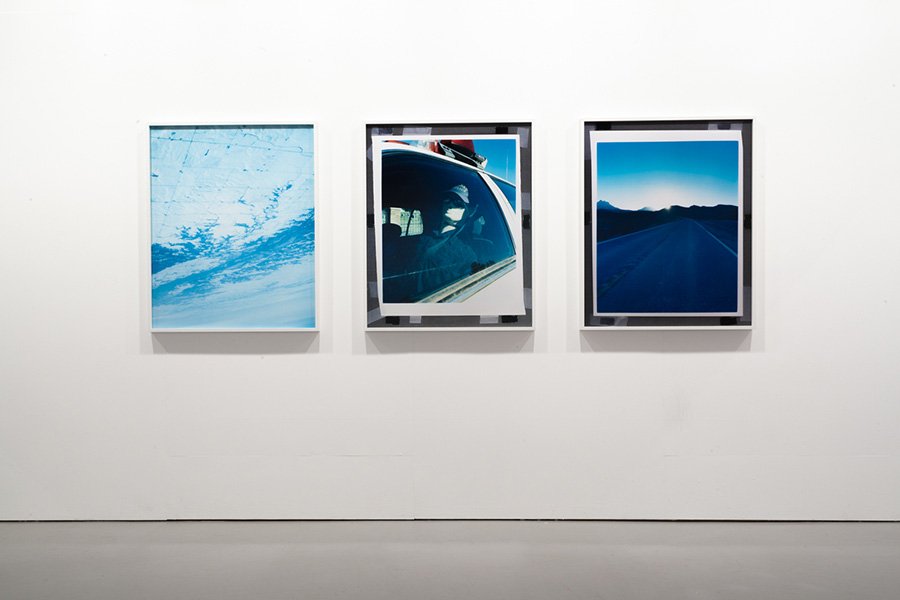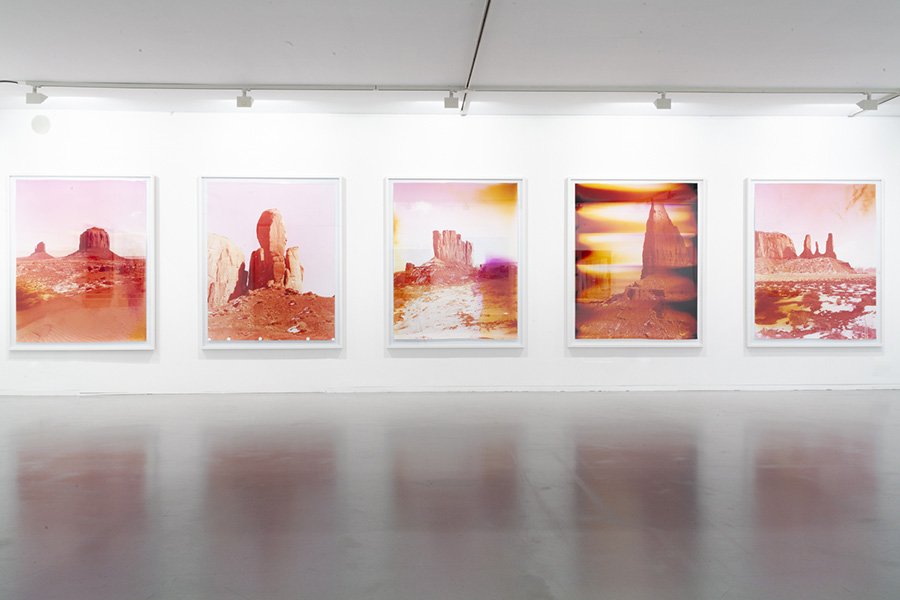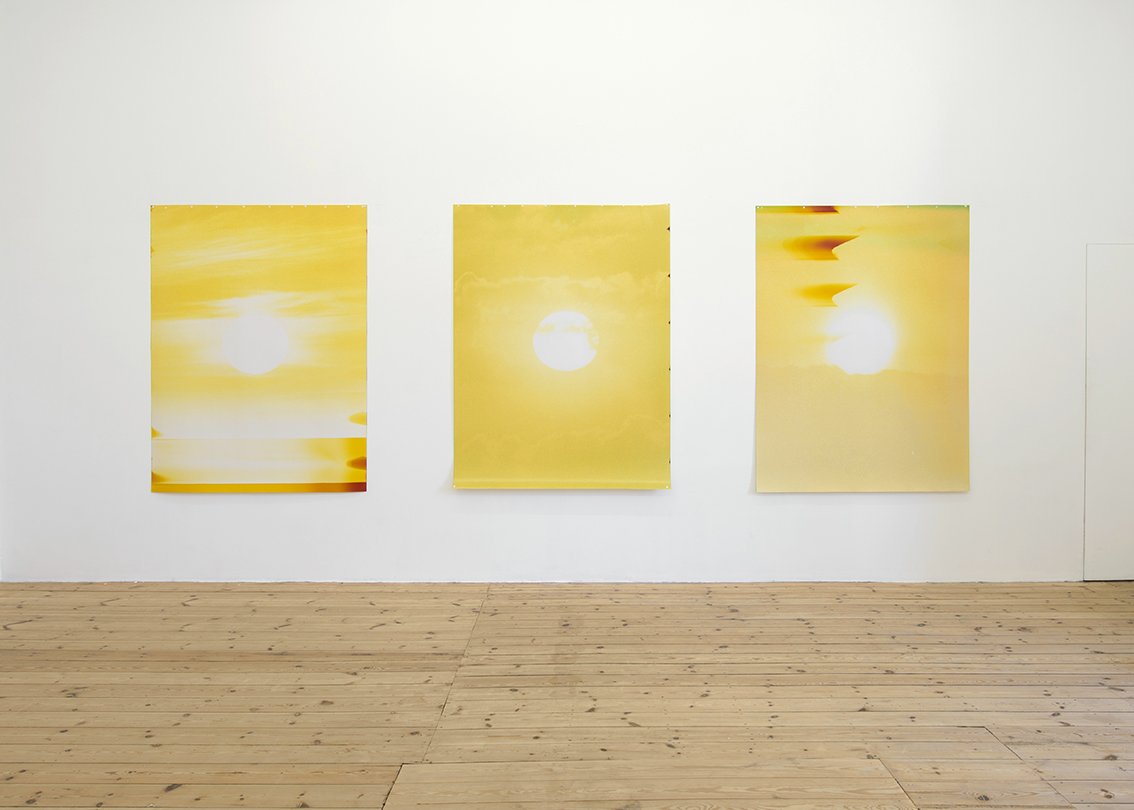Sébastien Reuzé
French, b. 1970
Rising Sunset, Catherine Bastide gallery, Brussels, 2017, exhibition view
Wanderings of a Photographer
Interview with Sébastien Reuzé
I am in the workshop of Sébastien Reuzé (1970). One of the walls is covered with metal panels on which pictures of different sizes are pinned with magnets. Here and there are found objects covered with crystals: joysticks and military objects. From the original interior design of the office building in which the workshop is situated, Reuzé has kept the gray rug with orange stripes and the hygienic false ceiling. This choice corresponds to his desire to show his latest series of photographs in a cold, technological environment that refers to the aesthetic of JG Ballard. Reuzé tells me that amongst the writings on art, he prefers interviews. So I decide to write an interview.
Reuzé: In 2010, I found that there were similarities between my work and Ballard’s universe. It had been a few years since I had an eclectic practice, which was not devoted to a main subject, and I wanted to develop my practice in a writing project: La Noë. I was looking for a topic that might resemble a documentary but which would allow me to fictionalize real things. Thus was born a trilogy on contemporary forms of violence.
Trilogy
The first part is based upon the novel The Concrete Island. To summarize, this is the story of a publicist in his forties who has a car accident. He finds himself between three access roads to a freeway and eventually abandons consumerism, modern comforts, his wife and his mistress. My work is dedicated to a family that is socially and geographically isolated in an unspoken form of political protest and rejection of the present. We feel that this withdrawal into a clan produces something very tense, an impoverishment, and finally, a form of self-surrender. We see people living in a green environment, in a small paradise resembling a prison. All signals that appear in the work are negatively connoted. I was thinking about people like Terrence Malick and Boris Mikhailov. It is not a literal translation of the novel, but a work I have undertaken with a family. It consists of four slideshows (each with 80 images) projected simultaneously with different exposure times so that the four projected slides are always combined differently.
The second part of the trilogy is based upon a novel by Ballard entitled Kingdom Come. The author invents a city in the western suburbs of London, south of Heathrow Airport. The city is called Brooklands and there are riots. Ballard juxtaposes consumerism, advertising, events in a mall, middle-class life, sports competition and racism.
During the summer of 2011, I moved to London for a few months to develop this work. I lived in an area called Hackney. I was just asking myself how I could film a car on fire when things went wrong in my neighborhood. Soon it proved that it doesn’t make sense to me to film real riots. What interests me is to paint a psychological landscape, a parallel world. That being said, a burning car is very beautiful and very meaningful. Cars are very important social markers and are designed objects that cost a lot of money. Pontiacs are works of art, coming from a genuine sensitivity. Cars are like mobile architecture forming part of the real, which adds geometry to a landscape. It is also a mechanical animal, one which replaced the horse. A wrecked car replaces the iconic skeleton emerging from the desert sand. Finally, I staged the burning of a BMW in a studio here in Brussels. It was lit with a Molotov cocktail; a one hour sequence shot, which became my version of Kingdom Come. Aside from that, I also did a film called Brooklands, a montage of photographs and films showing the escalating urban tensions supposed to happen in the city of Brooklands. Both films and the Brooklands Morning newspaper make up the box which constitutes the second part of the trilogy.
The third part of the trilogy is titled Indian Springs. It is not directly inspired by a novel, but by my interpretation of Ballard’s work. It is a series of framed photos that tell a fictional day of a drone pilot. Frankly, I'm not really inclined towards literature or science fiction, I don’t care specifically for space shuttles. What interests me in Ballard is the anticipation of something possible, something not really true or plausible. Here we see that military robotics, and the control of drones in particular, are very similar to video games. The display, by nature, distorts the real, it is an interface that acts as if what we saw on the screen was not true, fictive, invented. The screen acts as a filter that pushes us away from reality. And suddenly, there are people who get up in the morning, take their coffee, drive to the office in their Camaro or Ford Mustang, arrive at the base, salute the guys and have themselves seated in front of a screen to cause devastation. I try to say something about this in just a few images.
Colorblind Sands
Indian Springs gave birth to a new work which is related to the American road movie. The idea of he road movie comes from the psychological wanderings of a guy who drifts instead of representing the order as he is supposed to. This wandering could also be that of the photographer. Early in my photography practice, I was very influenced by the work of Garry Winogrand. I was quite aware that it is difficult to succeed with works of the sort, or that of many other people. I thought that to work on this theme, it was necessary to question the medium, not just make pretty pictures as we see so often. I thought, moreover, that it was interesting that this work would relate to my previous projects. So I used the same character, a pilot, who deserts (this is neither said or shown) and drifts through desert areas in the Southwest of the United States. Sometimes the same images, edited differently, end up in Indian Springs and in Colorblind Sands.
This time, I worked with a collection of stories entitled Vermilion Sands. These stories offer us almost a synthesis of Ballardian semantics and aesthetics. Visually, I borrowed the description of a seaside resort without water, without sea, which lies somewhere in what could be the southwestern desert of the United States. My work is rooted in the same landscape, which I approach visually in a manner which is influenced by Ballard’s descriptions. Concretely the work consists of analog photos of different formats. They will be presented on metal panels on the wall, arranged as if in an office or university. I am looking for almost administrative aesthetics to avoid being preachy, to create an ambiguous atmosphere, with beautiful pictures, mostly edited on photographic paper in a darkroom. Drones are technological animals, beautiful, and yet terrible weapons, reminding us of the horror of atomic bombs and landmines. They are poisonous flowers, giant carnivores. I find myself in the position of a documentary photographer and I photograph this demented flower, this icon of now, while I question myself on the meaning of this undertaking. Drones are economic and political symbols because they represent the power of a state that has the means to design them. They are absolute symbols of the idea of orror. The project’s goal is to create an ambiguity about the truth of what the pictures show. I’m looking for a narrative form, because I'm not a journalist. For me, it's more interesting to talk about it whilst breaking with the traditional form of objective documentary.
The ambiguity in meaning is extended to the form of the pictures. Sometimes the pictures materialize in analog prints (at times manipulated), that have been digitalized and printed by inkjet printers. Sometimes however they are just analog photographs that have been enlarged in a darkroom. This work aims to show the analog physical matter as malleable material that can be roughed up, which can suffer the hazards of time, but also as a material that evokes much more (such as skin, for example). It's about the editing process, the semantics of color and the darkroom, the plastic quality of photography, the possibility of a medium. Moreover, it is a work that is turned towards the future rather than the past. I do not consider analog photography as an archaic medium. I would like the photographic medium to be considered in its materiality, accepting dust on a slide as part of the medium. Photography could well be a medium which goes beyond its sole photographic representation. In other art forms, the medium serves as a project. In photography, the project must often serve the medium. In the past, I made photographic objects, such as screen printed flags with pictures of seagulls. Now, this set of photos, magnets on metal panels, could be considered a form of photography: it would erase the boundaries between photography and other artistic media. This abolishment of artistic boundaries interests me.
I called this series Colorblind Sands in reference to Vermilion Sands and because I'm colorblind. Learning the color printing process was very difficult and frustrating for me, because the dominant colors were difficult to recognize. I see colors as less saturated than others, with less magenta, less sensual. For the same reason, I started to work on colors, for example by printing shots in a single color. That being said, I do not like the allegiance of photography to painting, where photography tries to to be paint. The principle of this exhibition is to make present the work of the workshop. I do not want it to seem trashy or dirty, I just want to make visible the living dimension of the used materials and I would like to make the research and laboratory stage palpable. I do not want it to become an idea illustrated by several examples. I would like the work to show itself like life, with its mistakes. I want it to be abundant.
Montagne de Miel, August 25th 2015
Hans Theys: Interview with Sébastien Reuzé
Please find more information about Sébastien Reuzé here.































